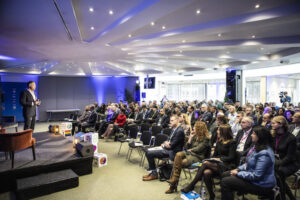
Women drive 90 percent of demand for jewelry industry products and are present across the entire value chain. However, women’s roles and opportunities in the jewelry supply chain are conditioned by gender inequalities and discrimination.
Furthermore, the COVID-19 pandemic has slowed and, in some cases, reversed progress toward gender equality across industries. Many of the hardest hit industries, including retail, are dominated by women. Jewelry retail in particular is one of the hardest-hit consumer goods categories, with sales dropping as much as four-fifths in certain regions in the early stages of the pandemic, and the impacts have cascaded throughout the industry and its supply chain, worsening many structural inequalities and challenges women already face.
In 2020, UN Women launched a ground-breaking campaign: “Generation Equality: Realizing women’s rights for an equal future,” marking the 25th anniversary of the Beijing Declaration and Platform for Action and bringing together multiple generations of women’s rights activists. This culminated in July in Paris, where business, governments and civil society committed to an ambitious global acceleration plan to achieve gender equality by 2030. This momentum and the resulting “she-cession” of the global pandemic increased the urgency for business to advance gender equality. Forty companies made individual and collaborative commitments to push for gender equality across their value chains.
Business can play a critical role in changing attitudes, building responsible practices throughout the supply chain and creating inclusive and safe work environments for everyone.
As part of Generation Equality, BSR, in partnership with RJC, engaged with a wide range of industry stakeholders across the globe through workshops, regional roundtable discussions and surveys. The resulting report, “Gender Equality Report: The time is now to accelerate SDG 5, achieve gender equality, and empower all women and girls,” sheds light on the current state of corporate efforts to advance gender equality in the jewelry industry. The report presents four major insights:
1. Enabling small and medium-sized enterprises (SMEs) to advance toward gender equality is a key opportunity for the entire industry
Gender equality efforts begin with high-level leadership commitments and transformational business policies that can set the pace for integrating gender equality across business value chains and teams. However, one of the biggest barriers toward achieving these commitments and policies across the industry is organizational size. SMEs often lack internal capacity, expertise or resources to develop formal policies, and gender equality is not prioritized as clearly as in larger organizations that face more expectation to act and commit to external initiatives.
As many as 35 percent of RJC members are SMEs who have not developed external commitments or vision statements, and 21 percent of RJC members have shared that they have limited formal policies. However, many SMEs have made internal commitments, have adopted informal policies, or promote inclusivity in other ways, such as company charters.
2. Social norms on gender and structural factors in companies are impacting access to talent
In the jewelry industry, accessing and hiring diverse talent, particularly women, is challenging. This issue is even more acute in particular regions, in the mining industry and for roles in logistics or STEM-based functions. However, some companies have begun to address these barriers to gender diversity. So, while many companies still focus on “hiring the best person for the job,” which may hamper efforts to increase gender diversity, the survey revealed that 24 percent of RJC member companies are reviewing their job positions and requirements to remove potential biases.
In addition, many other opportunities exist to implement hiring, development and retention plans. Practices, such as unconscious bias trainings for hiring teams, hiring and promotion target-setting, and creating focused development and learning opportunities for underrepresented groups, are still limited across members, meaning there is significant scope for improvement.
3. Globally, the conversation on diversity in the industry is centered on gender equality
However, in certain regions, the approach is shifting to broader diversity and inclusion dimensions, such as focusing on racial justice and ethnic diversity in North America and disability and age in Europe. Because dimensions of identity can create layers of discrimination for an individual, not all women have experienced the same level of progress toward gender equality in recent years. Companies should consider taking an intersectional approach to gender equality and understand how different dimensions of identity intersect with one another.
However, a shared challenge across many companies in the industry is where or how to start, as these issues are highly culturally sensitive and the regional context is critical to understanding the challenges and opportunities.
4. Organizations have an opportunity to amplify their impact and drive change in the industry by looking at their entire value chain
Businesses can enable more diversity in their value chains by taking a range of actions, including actively sourcing from entities that are led and/or owned by women or other underrepresented groups, focusing on worker well-being throughout their supply chains, and using their marketing practices to challenge stereotypes. However, value-chain initiatives in the industry are still largely limited. Only 2 percent of surveyed companies have commitments to procure from women-owned or minority-owned businesses. Lack of market access for smaller or women-owned businesses continues to be a significant barrier to value-chain diversity.
Where to from here?
Our dialogues and other engagements make it clear that industry-wide collaboration will be essential to tackling the systemic challenges to achieving gender equality. BSR and RJC are committed to supporting and stirring this industry-wide collaboration and furthering this dialogue with industry stakeholders to promote progress within individual organizations as well as the broader industry.
Source: https://www.greenbiz.com/article/advancing-equitable-vision-jewelry-industry









